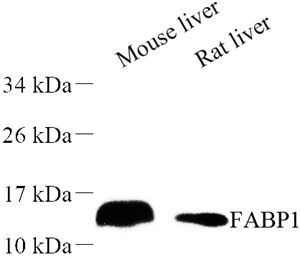Anti-FABP-1 Rabbit pAb (100 μl)
| Reactivity: | M,R |
| Applications: | WB |
| Host Species: | Rabbit |
| Clonality: | Polyclonal |
| Full Name: | FABP-1 rabbit polyclonal antibody |
Gene Name: | Fatty acid-binding protein, liver |
Synonyms: | 14 kDa selenium-binding protein, Fatty acid-binding protein 1, Liver-type fatty acid-binding protein, L-FABP |
Immunogen: | KLH conjugated Synthetic peptide corresponding to Mouse FABP-1 |
Isotype: | IgG |
Purity: | Affinity purification |
Predicted MW. | 14 kDa |
Observed MW. | 14 kDa |
Uniprot ID: | P12710, P02692 |
Product Usage Information
Applications | Species | Dilution | Positive tissue |
WB | Mouse, Rat | 1: 300-1: 600 | liver |
Background
Fatty acid binding proteins (FABP) are small intracellular proteins with a high degree of tissue specificity. FABPs are a class of cytoplasmic proteins that bind long chain fatty acids. They are abundantly present in various cell types and seem to play an important role in the intracellulair utilization of fatty acids. There are at least six distinct types of FABP, each showing a specific pattern of tissue expression. FABP leaks, due to its small size, rapidly out of ischemically damaged dying cells leading to a rise in serum levels. Liver FABP is a sensitive marker for cell damage of liver cells in vitro and in vivo. Ischemically damaged tissues are characterized histologically by absence (or low presence) of FABP facilitating recognition of such areas. Next to this L FABP is a marker for rapid hepatocyte lysis in vitro (as for example in toxicology assays) and for detection of liver damage during and after transplantation.
Images
|
|
Western blot analysis of FABP1 (GB111152) at dilution of 1: 300 |
Storage
| Storage | Store at -20°C for one year. Avoid repeated freeze/ thaw cycles. |
| Storage Buffer | PBS with 0.02% sodium azide, 100 μg/ml BSA and 50% glycerol. |

